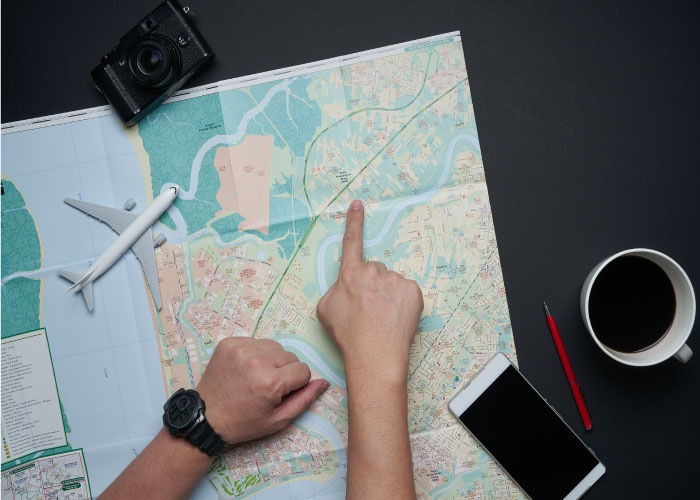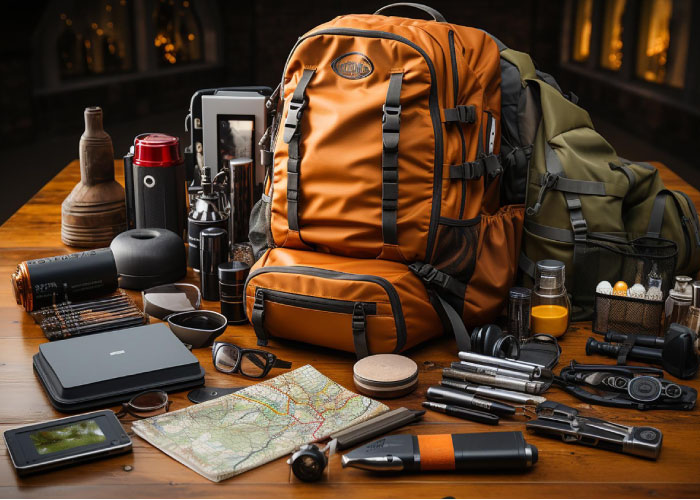Beginning a backpacking journey holds the promise of exhilarating adventures and unforgettable experiences, drawing outdoor enthusiasts to the call of the wild. Backpacking takes you beyond the confines of car-accessible campgrounds, offering a deeper and more engaging connection with the great outdoors. Whether you’re a novice explorer venturing into uncharted territories or a seasoned backpacker seeking new challenges, meticulous planning lays the foundation for a gratifying and trouble-free expedition. This how to plan a backpacking trip: a beginners’ guide is crafted to navigate you through the intricacies of planning a backpacking trip, ensuring every step is taken with confidence and foresight. Let’s talk about “HOW TO PLAN A BACKPACKING TRIP.”
A Complete Guideline for Backpacking Trip
Whether you’re a seasoned hiker or a beginner, having a comprehensive guideline ensures your journey is safe, enjoyable, and memorable. Here’s a complete guide to help you plan your backpacking trip.
Deciding Where to Go
Selecting the perfect destination for your backpacking trip is a crucial first step in the planning process. Do you feel drawn to the arid beauty of deserts, the rugged coastline, or the serene mountains? Research national parks and wilderness areas within these ecosystems, as they often offer the best backpacking experiences. Also, consider factors such as your skill level, the season, and the terrain you’re comfortable navigating.
Take into account safety factors such as weather patterns, potential hazards (e.g., wildlife encounters, river crossings), and emergency services available in the area. Choose a destination where you feel comfortable and confident navigating the terrain.
Ultimately, choose a destination that resonates with your interests and preferences. Whether you’re seeking solitude in remote wilderness or the camaraderie of popular hiking trails, prioritize destinations that align with your backpacking goals and aspirations.
Some popular backpacking destinations around the world include:
- Appalachian Trail (United States)
- Pacific Crest Trail (United States)
- John Muir Trail (United States)
- Torres del Paine Circuit (Chile)
- Inca Trail to Machu Picchu (Peru)
- West Coast Trail (Canada)
- Tour du Mont Blanc (France, Italy, Switzerland)
- Annapurna Circuit (Nepal)
- Milford Track (New Zealand)
- Overland Track (Australia)
Determining the trip duration and mileage
Once you have a working list of places you want to visit, it’s time to determine the trip duration and mileage. Here’s a breakdown of how to approach this step:
Assess Trail Difficulty:
Research the difficulty level of the trails at your chosen destination. Factors such as elevation gain, steepness of terrain, and trail conditions can significantly impact how far you’re able to hike in a day. Trails with rugged terrain or significant elevation changes may require slower progress compared to flat, well-maintained paths.
Consider Your Fitness Level and Experience:
Be honest with yourself about your physical fitness and hiking experience. If you’re new to backpacking or have limited endurance, you may want to start with shorter trips to build up your stamina gradually. Conversely, experienced hikers may feel comfortable tackling longer distances over multiple days.
Account for Elevation Gain:
Keep in mind that hiking uphill or at higher elevations can be more physically demanding and may slow your pace. Factor in breaks for rest and acclimatization, especially if you’re hiking in mountainous terrain where altitude sickness can be a concern.
Consider Weather Conditions:
Be mindful of the weather forecast for the duration of your trip. Inclement weather such as rain, snow, or extreme heat can affect trail conditions and impact your hiking speed. Plan for shorter distances or additional rest days if adverse weather is expected.
Calculate Daily Mileage:
Once you’ve taken these factors into account, estimate how many miles you’re comfortable hiking each day. Beginners may aim for shorter distances ranging from 5 to 10 miles per day, while experienced hikers might cover 10 to 20 miles or more, depending on the terrain and conditions.
Plan Your Trip Duration:
Based on your daily mileage goals, calculate the total distance you intend to cover and determine the number of days required to complete the hike. Be realistic about how much ground you can realistically cover each day, factoring in breaks, meals, and overnight camping.
Getting Permit (If needed)
When planning your backpacking trip, it’s crucial to determine if you’ll need a permit for camping in the backcountry. National and state parks almost always require permits, which can typically be obtained online through the respective park service websites. Wilderness areas and National Forests may have more relaxed permitting requirements, often offering free permits available at the trailhead without the need for advance registration. However, if permits are necessary, they’re usually required for each designated campsite or camping zone for each night of your trip. Be sure to research the specific permitting process for your chosen destination to ensure compliance with regulations.
Preparing Backpacking Gear
People usually ask “What gear do I need for backpacking?” Fret not! We would try to give you a complete guideline about all things need to know about backpacking. It’s essential to thoroughly acquaint yourself with your gear to ensure a smooth and enjoyable trip. Here’s a detailed breakdown of how to prepare your equipment:
Tent:
Set up your tent in your backyard or a local park to familiarize yourself with the setup process. Check for any tears, holes, or broken poles, and repair or replace them as needed. Test the zippers to ensure they’re functioning correctly, and consider applying waterproofing treatment if necessary. If you’re in the market for a new tent, consider options like the REI Co-op Half Dome 2 Plus Tent, known for its durability, spaciousness, and ease of setup.
Stove:
Test your camping stove in a controlled outdoor environment to ensure it’s working properly. Practice assembling and disassembling the stove, igniting the flame, and adjusting the heat settings. Check the fuel supply and carry extra fuel if needed. For a reliable backpacking stove, consider the lightweight and compact Jetboil Flash Cooking System, known for its rapid boiling time and efficient fuel usage.
Navigation Tools:
Familiarize yourself with your navigation tools, including maps, compass, and GPS device. Practice reading maps and identifying key landmarks, trail junctions, and elevation changes. Learn how to use a compass to determine direction and orient yourself with the map. Consider investing in a reliable GPS device like the Garmin inReach Mini, which provides real-time GPS tracking, messaging, and SOS capabilities for added safety and peace of mind.
Repair and Maintenance:
Inspect all of your gear for any signs of wear and tear, such as frayed straps, loose seams, or damaged buckles. Repair or replace any damaged components to ensure your equipment functions properly on the trail. Pack a repair kit with essential tools and materials, including duct tape, seam sealant, spare parts, and a multi-tool for on-the-go repairs.
Packing Strategy:
Pack your gear strategically to distribute weight evenly and maximize space in your backpack. Use compression sacks or stuff sacks to organize and compress bulky items like clothing and sleeping bags. Place heavier items closer to your back and towards the bottom of your pack to maintain stability and balance while hiking. Consider using a lightweight and adjustable backpack like the Osprey Atmos AG 65 Pack for optimal comfort and load carrying capacity.
By taking the time to thoroughly prepare and test your gear before hitting the trail, you’ll be better equipped to handle any challenges that may arise during your backpacking adventure. Additionally, investing in quality equipment from reputable brands ensures reliability and durability in the wilderness.
Planning the Route
Once you’ve packed (HOW TO PLAN A BACKPACKING TRIP) your gear, it’s time to plan your route and itinerary. Obtain detailed trail maps of your chosen destination from sources such as guidebooks, park websites, or outdoor retailers. Study the maps carefully to familiarize yourself with the trail network, including trailheads, junctions, and points of interest.
Research current trail conditions and recent trip reports to gain insights into the terrain, weather patterns, and potential hazards. Check for any trail closures, detours, or seasonal restrictions that may affect your route. Online forums, social media groups, and park rangers are valuable resources for obtaining up-to-date information from fellow hikers and local experts.
Identify designated campsites or backcountry camping areas along your route where you plan to spend the night. Ensure these campsites are within a reasonable distance from each other and offer access to water sources for drinking and cooking.
Allow flexibility in your schedule to accommodate unexpected delays, changes in weather, or opportunities for spontaneous exploration. Communicate your itinerary to a trusted friend or family member and leave a copy of your plans with someone responsible before departing on your trip.
Safety Matters
When venturing into the wilderness for a backpacking trip, safety is paramount. Here are some key safety precautions to consider:
Inform Someone: Always let a trusted person know your itinerary and expected return date. This ensures someone is aware of your whereabouts and can alert authorities if you do not return as scheduled.
Navigation: Carry a map, compass, or GPS device to aid in navigation. Familiarize yourself with their use before your trip, as these tools are vital if you become disoriented or lost.
Pack Essentials: Ensure you have enough food, water, and emergency supplies for the duration of your trip, plus extra in case of an unforeseen delay.
Weather Preparedness: The weather can change rapidly in the wilderness, so bring clothing and shelter suitable for a range of conditions. This includes rain gear, thermal layers, and a robust tent.
Stay Vigilant: Keep a keen eye on your surroundings to spot potential hazards, such as unstable terrain, wildlife, or changing weather patterns.
Trust Your Instincts: If something feels off or dangerous, trust your instincts and take the necessary precautions, whether that means altering your route or setting up camp early.
Leave No Trace
Before knowing,”HOW TO PLAN A BACKPACKING TRIP”. As outdoor enthusiasts, it’s our responsibility to preserve and protect the natural beauty of the wilderness for future generations. Practice Leave No Trace principles by packing out all trash, minimizing campfire impacts, respecting wildlife, staying on designated trails, and avoiding sensitive habitats. Leave the trail better than you found it, and inspire others to do the same by setting a positive example of responsible outdoor stewardship.
Conclusion
In brief “HOW TO PLAN A BACKPACKING TRIP” is a small but important planning. Planning a backpacking trip may seem daunting at first, but with careful preparation and attention to detail, anyone can experience the thrill of exploring the great outdoors. By following these steps and guidelines, you’ll be well-equipped to embark on your adventure with confidence and excitement. So grab your backpack, lace up your hiking boots, and hit the trail for an unforgettable journey into the wilderness!




